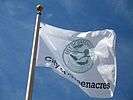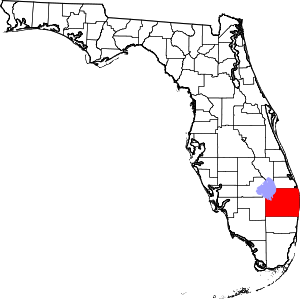Greenacres, Florida
Greenacres is a city in central Palm Beach County, Florida, United States. The population was 27,569 at the 2000 census. In 2010, the population recorded by the U.S. Census Bureau was 37,573.[6]
Greenacres, Florida | |
|---|---|
City | |
| City of Greenacres | |
 Flag | |
| Motto(s): "A Good Place to Live" | |
 Location of Greenacres, Florida | |
| Coordinates: 26°37′41″N 80°8′7″W | |
| Country | |
| State | |
| County | |
| Incorporated | May 24, 1926[1] |
| Government | |
| • Type | Council-Manager |
| • Mayor | Joel Flores[2] |
| • Deputy Mayor | Paula Bousquet |
| • Councilmembers | John Tharp, Peter A. Noble, Judith Dugo, and Jonathan G. Pearce |
| • City Manager | Andrea McCue |
| • City Clerk | Melody Larson |
| Area | |
| • Total | 5.89 sq mi (15.25 km2) |
| • Land | 5.85 sq mi (15.15 km2) |
| • Water | 0.04 sq mi (0.10 km2) |
| Population (2010) | |
| • Total | 37,573 |
| • Estimate (2019)[4] | 41,117 |
| • Density | 7,024.11/sq mi (2,711.89/km2) |
| Time zone | UTC-5 (Eastern (EST)) |
| • Summer (DST) | UTC-4 (EDT) |
| ZIP codes | 33400-33499 |
| Area code(s) | 561 |
| FIPS code | 12-27322[5] |
| GNIS feature ID | 283408 |
| Website | http://greenacresfl.gov/ |
History
In 1909, Frederick E. Bryant – a British agriculturalist, – Harold J. Bryant, and William Greenwood of the Palm Beach Farms Company in Colorado, bought thousands of acres of land in the Everglades and later along the coast of Lake Worth in 1910. The men sold the land to buyers throughout the United States and Canada, offering 5 acres (2.0 ha) plots for $250, with a $10 down payment and a $10 per month charge, which also included a 25 by 25 ft (7.6 by 7.6 m) parcel on the shore of Lake Worth. However, difficulties involved with farming in the Everglades forced 308 buyers to settle at their properties along Lake Worth, an area that would later become the city of Lake Worth. Until the land boom of the 1920s, these lots were effectively abandoned. Around that time, Lawrence Carter "L. C." Swain of Massachusetts acquired 320 acres (130 ha) of land, with the intention of creating a community for the working class. He initially platted approximately half of the land in 1923, with a plat just west of Military Trail becoming the original section of the city. By 1925, Swain began selling lots for $225.[7]
The town was originally incorporated as Greenacres City on May 24, 1926.[7] The name Greenacres was the winning entry in a local naming contest.[8] Upon incorporating, the town had an estimated 1,250 residents. Greenacres City was almost completely destroyed by the 1926 Miami hurricane and again by the 1928 Okeechobee hurricane. Swain died in 1944; Swain Boulevard and L. C. Swain Middle School are named in his honor. In 1945, about 125 residents petitioned for the Florida Legislature to abolish the Greenacres City as a municipality.[7] The legislature passed a bill to dis-incorporate Greenacres City in April of that year, which became a law on April 24, 1945, without the signature of Governor Millard Caldwell. Then-Mayor Charles A. Grabowski actively fought the new law, as no referendum to forfeit the town's charter had been held.[9] Additionally, Grabowski accused a resident of starting the dissolution movement out of spite after being denied a homestead exemption and claimed that many of the signatories did not actually own property in Greenacres City. Grabowski also asserted that the pleas of city officials and a large number of residents in favor of remaining a town were ignored.[10]
On December 4, 1945, a meeting was held to reincorporate Greenacres City. A total of 86 out of 120 registered voters turned out, more than the two-thirds of voters quorum required. The 86 voters unanimously decided to reincorporate.[11] The area's rights as a city were restored, while Greenacres City was officially reincorporated in 1947. Over the subsequent decades, Greenacres City eventually expanded to 6 sq mi (16 km2) through annexation.[7] In the 1960s, a city hall complex was constructed at the intersection of Perry Avenue and Fourth Street, while a community center was built nearby. The city hall complex originally included a public library and all other city departments, except for the fire and public works departments. By the 1970s, full-time police and fire departments were established. In response to concerns about future growth, residents approved a bond referendum in 1984 to fund construction of a new city hall, a public safety complex, and recreational facilities.[12]
In 1990, about 60% of voters chose to drop the word "city" from the official name, thus renaming the municipality Greenacres.[13] After the 1990 census indicated a population of 18,638, city council authorized a special census in 1993, which added more than 3,000 additional residents to the official population count, making Greenacres eligible for funds from the state government of Florida.[12] To commemorate the city's 80th anniversary, the Greenacres Historical Society was formed in 2006, with a museum established two years later.[14] In July 2007, construction was completed on a new city hall and public works facility on Melaleuca Lane.[12]
Geography
Greenacres is located at 26°37′41″N 80°8′7″W (26.628045, -80.135389).[15]
According to the United States Census Bureau, the city has a total area of 5.79 square miles (15.0 km2), all land.
Demographics
| Historical population | |||
|---|---|---|---|
| Census | Pop. | %± | |
| 1930 | 329 | — | |
| 1940 | 304 | −7.6% | |
| 1950 | 531 | 74.7% | |
| 1960 | 1,026 | 93.2% | |
| 1970 | 1,731 | 68.7% | |
| 1980 | 8,780 | 407.2% | |
| 1990 | 18,683 | 112.8% | |
| 2000 | 27,569 | 47.6% | |
| 2010 | 37,573 | 36.3% | |
| Est. 2019 | 41,117 | [4] | 9.4% |
| U.S. Decennial Census[16] | |||
| Greenacres demographics | |||
|---|---|---|---|
| 2010 Census | Greenacres | Palm Beach County | Florida |
| Total population | 37,573 | 1,320,134 | 18,801,310 |
| Population, percent change, 2000 to 2010 | +36.3% | +16.7% | +17.6% |
| Population density | 6,487.5/sq mi | 670.2/sq mi | 350.6/sq mi |
| White or Caucasian (including White Hispanic) | 67.0% | 73.5% | 75.0% |
| (Non-Hispanic White or Caucasian) | 40.8% | 60.1% | 57.9% |
| Black or African-American | 17.0% | 17.3% | 16.0% |
| Hispanic or Latino (of any race) | 38.3% | 19.0% | 22.5% |
| Asian | 3.0% | 2.4% | 2.4% |
| Native American or Native Alaskan | 0.7% | 0.5% | 0.4% |
| Pacific Islander or Native Hawaiian | 0.1% | 0.1% | 0.1% |
| Two or more races (Multiracial) | 3.2% | 2.3% | 2.5% |
| Some Other Race | 9.0% | 3.9% | 3.6% |
As of 2010, there were 17,249 households out of which 16.6% were vacant. As of 2000, 24.5% had children under the age of 18 living with them, 45.9% were married couples living together, 12.5% had a female householder with no husband present, and 37.1% were non-families. 29.7% of all households were made up of individuals and 15.1% had someone living alone who was 65 years of age or older. The average household size was 2.29 and the average family size was 2.80.
In 2000, 20.9% of the population were under the age of 18, 7.6% from 18 to 24, 28.5% from 25 to 44, 19.4% from 45 to 64, and 23.6% who were 65 years of age or older. The median age was 40 years. For every 100 females, there were 87.9 males. For every 100 females age 18 and over, there were 84.2 males.
In 2000, the median household income was $36,941 and the median family income was $41,250. Males had a median income of $30,207 compared with $25,141 for females. The per capita income for the city was $19,298. About 5.0% of families and 7.2% of the population were below the poverty line, including 8.8% of those under age 18 and 6.5% of those age 65 or over.
As of 2000, speakers of English as a first language accounted for 73.64% of all residents, while Spanish accounted for 21.02%, Italian for 1.69%, French Creole made up 1.09%, German was at 0.71%, and French was the mother tongue for 0.45% of the population.[17]
As of 2000, Greenacres had the ninety-ninth highest percentage of Cuban residents in the US, with 2.41% of the populace (tied with Forest, Mississippi,)[18] and the ninety-seventh highest percentage of Colombian residents in the US, at 1.67% of the city's population.[19]
Education
Public Elementary Schools
- Cholee Lake Elementary School
- Diamond View Elementary School
- Greenacres Elementary School
- Heritage Elementary School
- Liberty Park Elementary School
- Forest Hill Elementary School
Public Middle Schools
- L. C. Swain Middle School
- Okeeheelee Middle School
- Tradewinds Middle School
Public High School
- John I. Leonard High School
References
- "Greenacres". www.pbchistoryonline.org. Retrieved April 17, 2017.
- "Greenacres elects new mayor, keeps councilwoman". The Palm Beach Post. March 14, 2017. Retrieved April 17, 2017.
- "2018 U.S. Gazetteer Files". United States Census Bureau. Retrieved Jul 19, 2019.
- "Population and Housing Unit Estimates". Retrieved May 21, 2020.
- "U.S. Census website". United States Census Bureau. Retrieved 2008-01-31.
- "Archived copy". Archived from the original on 2015-01-04. Retrieved 2015-01-04.CS1 maint: archived copy as title (link)
- "Greenacres". Historical Society of Palm Beach County. Retrieved 30 May 2015.
- Eliot Kleinberg (September 16, 1987). "A Town By Any Other Name". The Palm Beach Post. p. D1. Retrieved September 13, 2019 – via Newspapers.com.

- "Greenacres Act Becomes Valid". The Palm Beach Post. April 26, 1945. p. 12. Retrieved October 7, 2018 – via Newspapers.com.

- "Mayor Charges "Spite" Behind Move To Abolish Greenacres". The Palm Beach Post. April 22, 1945. p. 20. Retrieved October 7, 2018 – via Newspapers.com.

- "Greenacres Voters Okay Incorporation". The Palm Beach Post. December 5, 1945. p. 1. Retrieved October 25, 2018 – via Newspapers.com.

- "Greenacres Historical Events". City of Greenacres. Retrieved November 2, 2018.
- Sonja Isger (November 7, 1990). "Mayor sees city reborn as 'City' tag dropped". The Palm Beach Post. p. 42. Retrieved October 25, 2018 – via Newspapers.com.

- "Greenacres Historical Society". Greenacres Historical Society Museum. Retrieved November 2, 2018.
- "US Gazetteer files: 2010, 2000, and 1990". United States Census Bureau. February 12, 2011. Retrieved April 23, 2011.
- "Census of Population and Housing". Census.gov. Retrieved June 4, 2015.
- "MLA Data Center Results for Greenacres, Florida". Modern Language Association. Retrieved November 20, 2007.
- "Ancestry Map of Cuban Communities". Epodunk.com. Retrieved November 20, 2007.
- "Ancestry Map of Colombian Communities". Epodunk.com. Retrieved November 20, 2007.

